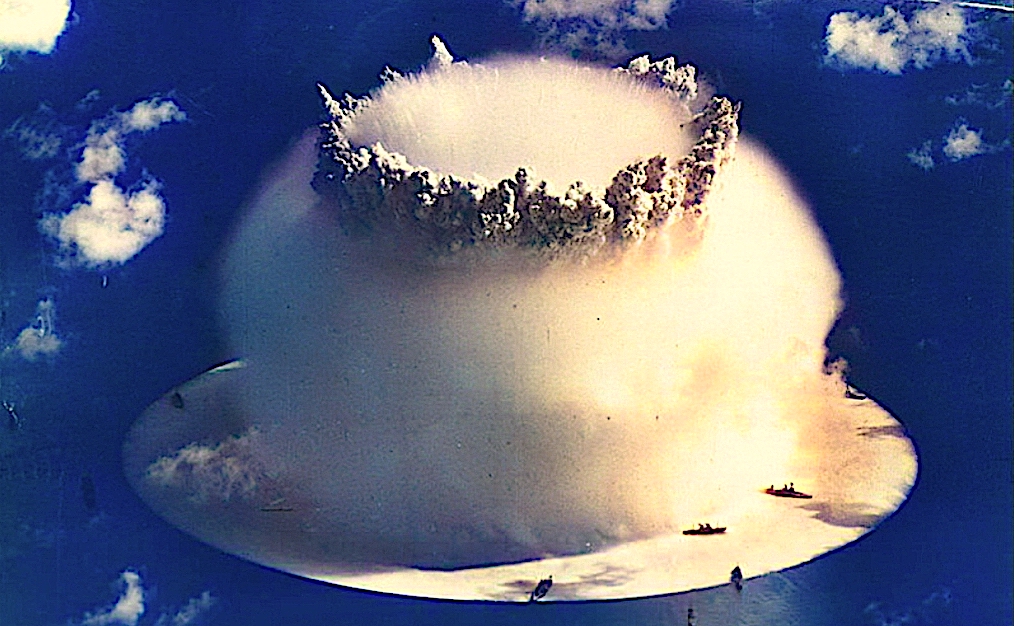How Would a Nuclear War Affect Our Climate and Oceans?

Scientists ran simulations on a variety of nuclear war scenarios — and some of the potential impacts would last thousands of years.
Research need
With more than 13,000 nuclear weapons in the world, states with nuclear weapons have embarked on plans to modernize or expand their nuclear arsenals. The presence of these weapons creates a risk that unstable leaders, hackers, or computer failure will launch the weapons intentionally or unintentionally.
In the event of nuclear war, urban firestorms — which create and sustain their own wind systems — would loft soot into the upper troposphere and lower stratosphere. The resulting reduction of sunlight would lead to global cooling that could trigger changes in the ocean system. Impacts of the nuclear cooling event could include expansion of sea ice into populated coastal areas and affect marine life.
What other changes within the ocean ecosystem could global cooling events potentially cause?
What did they study?
Researchers investigated what would drive a new state in global marine productivity, including how long this new state would likely persist, comparing the impacts of a large-scale nuclear war to smaller events.
To understand the long-lasting effects of a nuclear war on the ocean environment, scientists simulated climate impacts of nuclear war in a large U.S.–Russia nuclear war and a smaller scale India–Pakistan regional war.
What did they find?
A new physical and biogeochemical ocean state would result from the impacts of various-sized nuclear wars. These impacts can include a decrease in nutrients at higher latitudes, as well as result in thicker Arctic sea ice.
Additionally, researchers found that phytoplankton production and community structure would suffer, due to changes in light, temperature, and nutrients.
Anything else?
In the largest U.S.–Russia nuclear war scenario, recovery of ocean temperatures would take decades at the surface and hundreds of years at greater depths. After 30-years, the deep ocean would still be cooling. In addition, changes to Arctic sea-ice likely would last thousands of years in a “Nuclear Little Ice Age.”
In contrast, productivity would increase in the tropics and subtropics with conditions suitable for broadscale seaweed production.
With lower ocean temperatures, growth rates of fish would slow. Global fish biomass would decline by approximately 20% over the first 10 years of a post U.S.–Russia war.
Not surprisingly, marine ecosystems would be highly disrupted by both the initial impact and long-term changes to the ocean, which would impact ecosystems and fisheries globally.
Reading
Harrison, C.S., Rohr, T., DuVivier, A., Maroon, E.A., Bachman, S., Bardeen, C.G., Coupe, J., Garza, V., Heneghan, R., Lovenduski, N.S. and Neubauer, P., 2022. A new ocean state after nuclear war. AGU Advances, 3(4), p.e2021AV000610.
Funding for this study was provided by the Open Philanthropy Project. The data from the RAPID AMOC monitoring project was funded by the Natural Environment Research Council.
by Lauren D. Pharr
lead photo: A 21 kiloton underwater nuclear weapons effects test, known as “Operation Crossroads (Event Baker),” conducted at Bikini Atoll in 1946. Credit: U.S. Army Photographic Signal Corps.
The text from Hook, Line & Science is available to reprint and republish, but only in its entirety and with this attribution: Hook, Line & Science, courtesy of Scott Baker and Sara Mirabilio, North Carolina Sea Grant. HookLineScience.com
- Categories:



